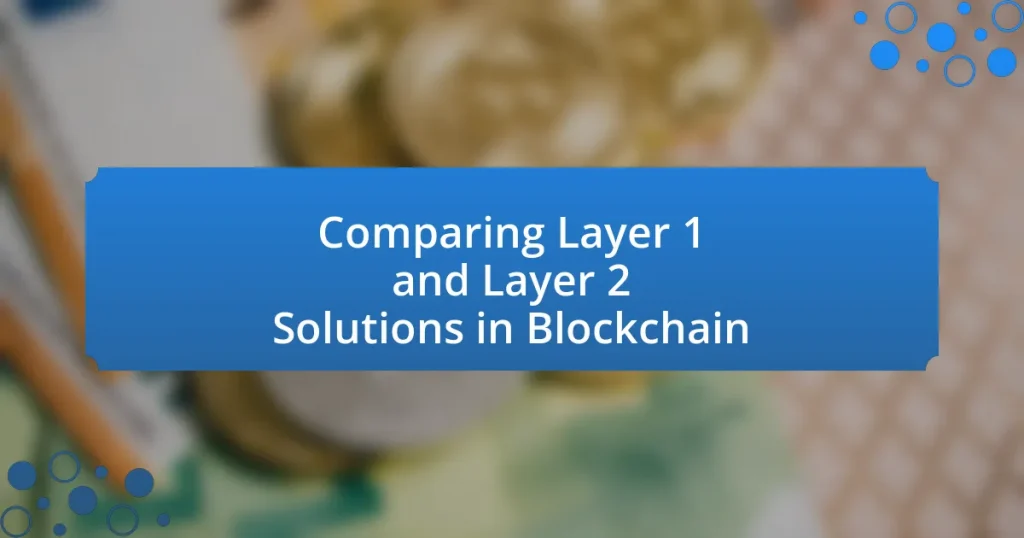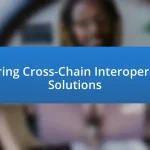Layer 1 and Layer 2 solutions are critical components of blockchain technology, each serving distinct functions within the ecosystem. Layer 1 solutions, such as Bitcoin and Ethereum, form the foundational blockchain architecture, managing transaction validation and consensus mechanisms directly on the blockchain. In contrast, Layer 2 solutions, including the Lightning Network and Optimistic Rollups, enhance scalability and transaction speed by processing transactions off the main chain. This article explores the functionalities, advantages, and disadvantages of both Layer 1 and Layer 2 solutions, their applications across various industries, and future trends in blockchain technology, providing a comprehensive comparison essential for understanding their roles in enhancing blockchain performance.
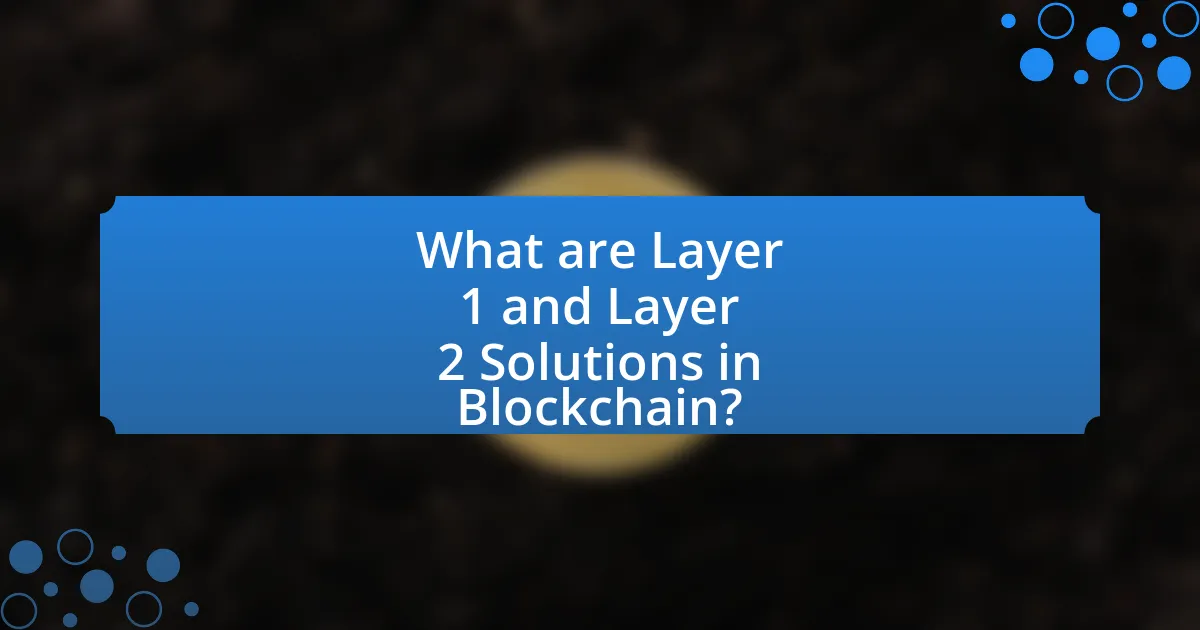
What are Layer 1 and Layer 2 Solutions in Blockchain?
Layer 1 solutions in blockchain refer to the base layer of the blockchain architecture, which includes the core protocol and the underlying network that processes transactions and maintains the ledger. Examples of Layer 1 solutions include Bitcoin and Ethereum, which handle transactions directly on their respective blockchains. Layer 2 solutions, on the other hand, are built on top of Layer 1 blockchains to enhance scalability and transaction speed by processing transactions off the main chain. Notable Layer 2 solutions include the Lightning Network for Bitcoin and Optimistic Rollups for Ethereum, which allow for faster and cheaper transactions while still leveraging the security of the underlying Layer 1 blockchain.
How do Layer 1 solutions function within blockchain technology?
Layer 1 solutions function as the foundational layer of blockchain technology, providing the core protocol that enables the network to operate. These solutions manage the blockchain’s consensus mechanism, transaction validation, and data storage directly on the blockchain itself. For example, Bitcoin and Ethereum are prominent Layer 1 blockchains that utilize their own native protocols to facilitate peer-to-peer transactions and smart contracts, respectively. The effectiveness of Layer 1 solutions is evidenced by their ability to maintain security and decentralization while processing transactions, with Bitcoin achieving a block time of approximately 10 minutes and Ethereum transitioning to a proof-of-stake model to enhance scalability and energy efficiency.
What are the key characteristics of Layer 1 solutions?
Layer 1 solutions are foundational blockchain networks that operate independently and provide the core functionalities necessary for decentralized applications. Key characteristics include scalability, which allows the network to handle a high volume of transactions; security, ensuring the integrity and safety of data through consensus mechanisms like Proof of Work or Proof of Stake; and decentralization, which distributes control across a network of nodes to prevent single points of failure. For example, Bitcoin and Ethereum exemplify Layer 1 solutions, demonstrating these characteristics through their ability to process transactions securely and maintain a decentralized ledger.
How do Layer 1 solutions ensure security and decentralization?
Layer 1 solutions ensure security and decentralization through their consensus mechanisms and network architecture. These solutions, such as Bitcoin and Ethereum, utilize protocols like Proof of Work or Proof of Stake to validate transactions and secure the network, making it difficult for any single entity to gain control. For instance, Bitcoin’s Proof of Work requires significant computational power, which decentralizes control among miners and enhances security by making attacks costly and impractical. Additionally, the open-source nature of Layer 1 protocols allows for community oversight and participation, further promoting decentralization and security through collective validation and governance.
What role do Layer 2 solutions play in enhancing blockchain performance?
Layer 2 solutions significantly enhance blockchain performance by increasing transaction throughput and reducing latency. These solutions, such as state channels and rollups, operate on top of the primary blockchain (Layer 1) and allow for off-chain transactions, which alleviates congestion on the main chain. For instance, the Lightning Network for Bitcoin can process millions of transactions per second, compared to Bitcoin’s base layer, which handles approximately 7 transactions per second. This scalability enables faster and cheaper transactions, making blockchain technology more viable for everyday use.
What are the primary features of Layer 2 solutions?
Layer 2 solutions primarily feature scalability, reduced transaction costs, and faster transaction speeds. These solutions, such as state channels and rollups, enable blockchains to process a higher volume of transactions off the main chain, alleviating congestion. For instance, Ethereum’s rollups can increase throughput significantly by bundling multiple transactions into a single one, thereby lowering fees and enhancing speed. This capability is essential for improving user experience and supporting decentralized applications, as evidenced by the growing adoption of Layer 2 technologies in the Ethereum ecosystem.
How do Layer 2 solutions improve transaction speed and scalability?
Layer 2 solutions improve transaction speed and scalability by processing transactions off the main blockchain (Layer 1) while still leveraging its security. These solutions, such as state channels and rollups, allow for a higher volume of transactions to be executed in parallel or aggregated, significantly reducing congestion on the main chain. For instance, Ethereum’s Optimistic Rollups can increase throughput to thousands of transactions per second compared to the base layer’s limit of around 30 transactions per second. This offloading of transaction processing not only enhances speed but also lowers fees, making the network more efficient and accessible for users.
Why is it important to compare Layer 1 and Layer 2 solutions?
Comparing Layer 1 and Layer 2 solutions is important because it helps stakeholders understand the scalability, security, and cost-effectiveness of blockchain networks. Layer 1 solutions, such as Bitcoin and Ethereum, operate on the base protocol and are responsible for the core functionalities of the blockchain, including transaction validation and consensus mechanisms. In contrast, Layer 2 solutions, like the Lightning Network or Optimistic Rollups, are built on top of Layer 1 to enhance transaction throughput and reduce fees. By analyzing these differences, developers and users can make informed decisions about which solutions best meet their needs, particularly in terms of performance and user experience. This comparison is crucial as it directly impacts the adoption and efficiency of blockchain technology in various applications.
What are the advantages and disadvantages of Layer 1 solutions?
Layer 1 solutions offer several advantages and disadvantages. The primary advantage is that they provide a foundational layer for blockchain networks, ensuring security and decentralization through consensus mechanisms like Proof of Work or Proof of Stake. This foundational security is critical for maintaining trust and integrity in transactions. Additionally, Layer 1 solutions can enhance scalability by implementing upgrades such as sharding or increasing block size, which can improve transaction throughput.
Conversely, the disadvantages of Layer 1 solutions include limited scalability compared to Layer 2 solutions, as they often face challenges in handling high transaction volumes without compromising speed or increasing fees. Furthermore, changes to Layer 1 protocols can be complex and require consensus among network participants, making upgrades slow and potentially contentious. For example, Bitcoin’s block size debate illustrates the difficulties in reaching agreement on protocol changes.
What are the advantages and disadvantages of Layer 2 solutions?
Layer 2 solutions offer significant advantages, including increased transaction speed and reduced fees, while their disadvantages include potential security risks and reliance on the underlying Layer 1 blockchain. The increased transaction speed is achieved by processing transactions off the main blockchain, which alleviates congestion and allows for faster confirmations. For instance, solutions like the Lightning Network for Bitcoin can handle thousands of transactions per second, compared to the limited capacity of the base layer. However, the reliance on Layer 1 means that if the underlying blockchain experiences issues, it can affect the Layer 2 solution’s performance and security. Additionally, some Layer 2 solutions may introduce complexities that could lead to vulnerabilities, as seen in various incidents where smart contract flaws were exploited.
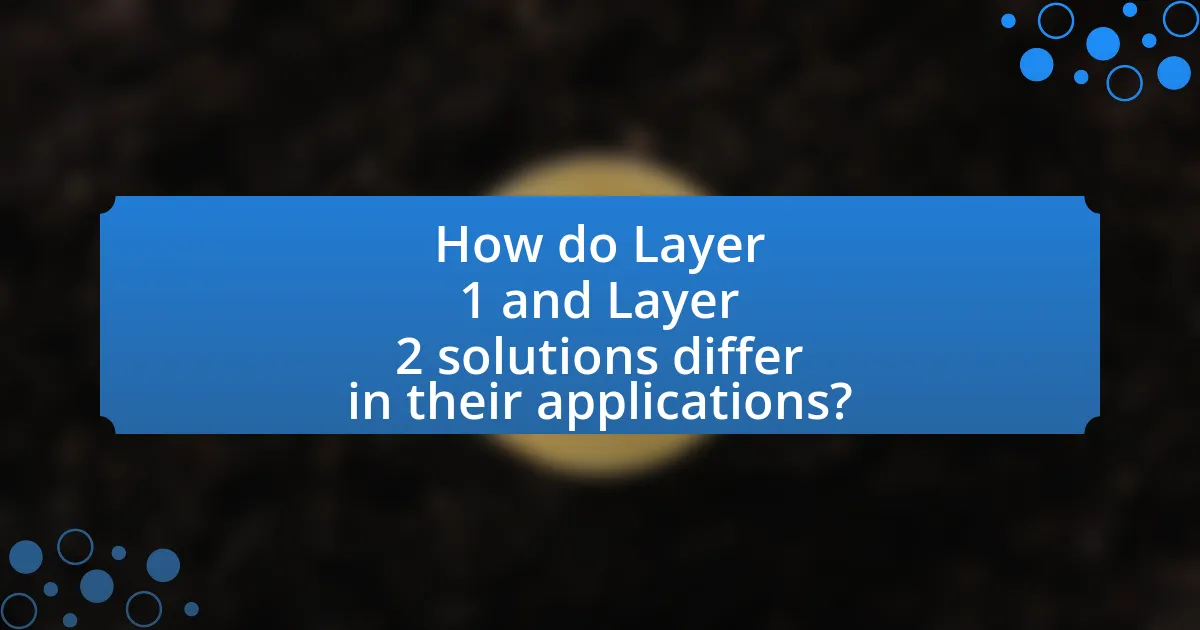
How do Layer 1 and Layer 2 solutions differ in their applications?
Layer 1 solutions are foundational blockchain protocols that handle all transactions and smart contracts directly on the main chain, while Layer 2 solutions operate on top of Layer 1 to enhance scalability and transaction speed by processing transactions off the main chain. For instance, Bitcoin and Ethereum are examples of Layer 1, where all operations occur on the blockchain itself, leading to potential congestion and higher fees during peak usage. In contrast, Layer 2 solutions like the Lightning Network for Bitcoin or Optimistic Rollups for Ethereum allow for faster and cheaper transactions by bundling multiple transactions together before settling them on the Layer 1 chain, thus alleviating congestion and reducing costs. This distinction in application highlights how Layer 1 focuses on security and decentralization, while Layer 2 prioritizes scalability and efficiency.
What types of use cases are best suited for Layer 1 solutions?
Layer 1 solutions are best suited for use cases that require high security, decentralization, and scalability. These use cases include cryptocurrency transactions, smart contracts, and decentralized applications (dApps) that need to operate on a secure and immutable blockchain. For instance, Bitcoin and Ethereum exemplify Layer 1 solutions that facilitate peer-to-peer transactions and enable developers to build complex applications directly on their networks. The inherent characteristics of Layer 1, such as robust consensus mechanisms and native token support, make them ideal for foundational blockchain functionalities.
How do Layer 1 solutions support decentralized applications?
Layer 1 solutions support decentralized applications by providing the foundational blockchain infrastructure that enables secure, scalable, and efficient transactions. These solutions, such as Bitcoin and Ethereum, offer native consensus mechanisms, like Proof of Work or Proof of Stake, which ensure the integrity and security of the network. For example, Ethereum’s smart contract functionality allows developers to build decentralized applications directly on its blockchain, facilitating automated and trustless interactions. Additionally, Layer 1 solutions typically have lower latency and higher throughput compared to Layer 2 solutions, which enhances the user experience for decentralized applications.
What industries primarily utilize Layer 1 solutions?
Layer 1 solutions are primarily utilized in industries such as finance, supply chain management, healthcare, and gaming. In the finance sector, Layer 1 solutions enable secure and efficient transactions, exemplified by Bitcoin and Ethereum, which facilitate decentralized finance (DeFi) applications. The supply chain industry leverages Layer 1 for tracking goods and ensuring transparency, with platforms like VeChain providing real-time data on product provenance. In healthcare, Layer 1 solutions support secure patient data management and interoperability, enhancing data sharing among providers. The gaming industry utilizes Layer 1 for creating decentralized gaming ecosystems, allowing for true ownership of in-game assets through blockchain technology. These industries benefit from the scalability, security, and decentralization that Layer 1 solutions offer.
What specific scenarios benefit from Layer 2 solutions?
Layer 2 solutions benefit scenarios that require high transaction throughput, low latency, and reduced fees. For instance, decentralized finance (DeFi) applications often experience congestion on Layer 1 blockchains, leading to slow transaction times and high costs; Layer 2 solutions like Optimistic Rollups or zk-Rollups can alleviate these issues by processing transactions off-chain and then settling them on-chain, significantly increasing efficiency. Additionally, gaming applications that demand rapid interactions and microtransactions can leverage Layer 2 to enhance user experience by minimizing delays and costs associated with on-chain transactions.
How do Layer 2 solutions facilitate microtransactions?
Layer 2 solutions facilitate microtransactions by enabling faster and cheaper transactions on blockchain networks. These solutions, such as state channels and rollups, operate on top of Layer 1 blockchains, allowing multiple transactions to be bundled together and settled off-chain. This significantly reduces the fees associated with each transaction, making it economically viable to conduct microtransactions, which typically involve small amounts of value. For instance, the Lightning Network, a Layer 2 solution for Bitcoin, allows users to conduct thousands of transactions per second with minimal fees, demonstrating the effectiveness of Layer 2 in supporting microtransactions.
What are the implications of Layer 2 solutions for gaming and DeFi?
Layer 2 solutions significantly enhance scalability and reduce transaction costs for both gaming and decentralized finance (DeFi). In gaming, these solutions enable faster transaction speeds and lower fees, which are crucial for real-time interactions and microtransactions, thereby improving user experience and engagement. For DeFi, Layer 2 solutions facilitate increased transaction throughput, allowing for more efficient trading and lending activities, which can lead to greater liquidity and user participation. The Ethereum network, for example, has seen Layer 2 implementations like Optimism and Arbitrum, which have successfully reduced gas fees and improved transaction speeds, demonstrating their effectiveness in real-world applications.
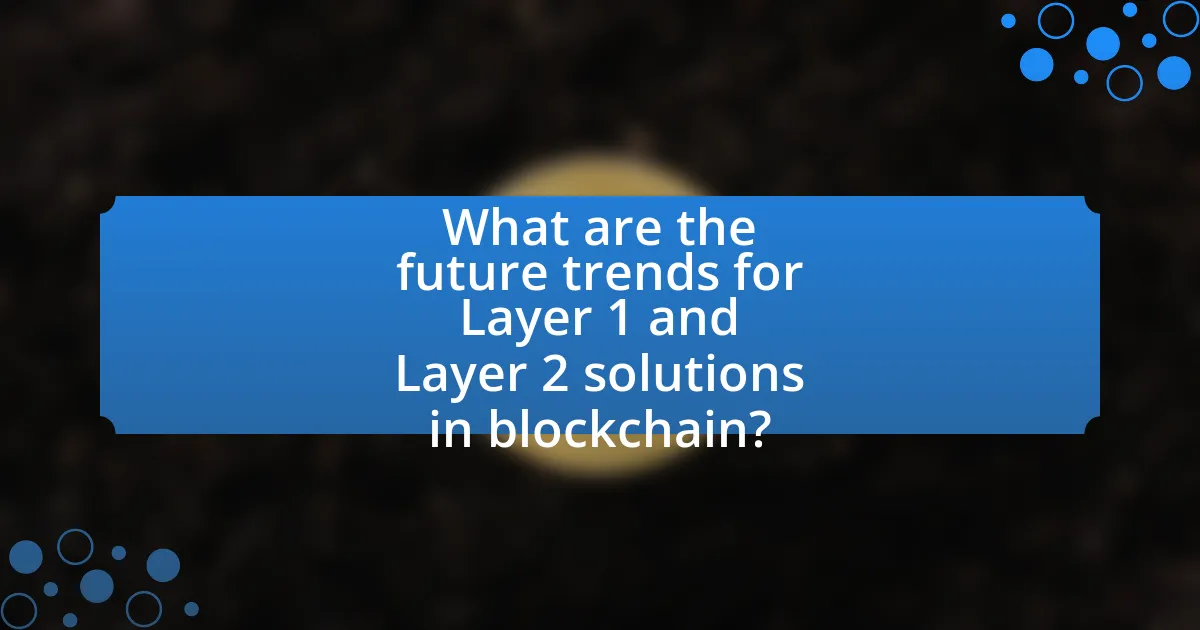
What are the future trends for Layer 1 and Layer 2 solutions in blockchain?
Future trends for Layer 1 and Layer 2 solutions in blockchain include increased interoperability, enhanced scalability, and improved user experience. Layer 1 solutions are evolving to incorporate sharding and consensus mechanism innovations, such as proof-of-stake, to boost transaction throughput and reduce energy consumption. For instance, Ethereum 2.0 aims to transition to proof-of-stake to enhance scalability and sustainability.
Layer 2 solutions, such as rollups and state channels, are gaining traction as they allow for off-chain transactions that significantly reduce congestion on the main blockchain. The adoption of these technologies is evidenced by the growing number of decentralized applications utilizing Layer 2 solutions, which can process thousands of transactions per second while maintaining security.
Furthermore, the integration of Layer 1 and Layer 2 solutions is expected to create a more seamless ecosystem, enabling developers to build more complex applications without compromising on speed or cost. This trend is supported by the increasing investment in Layer 2 technologies, which reached over $1 billion in 2021, indicating strong market confidence in their potential to address existing blockchain limitations.
How are Layer 1 solutions evolving to meet new challenges?
Layer 1 solutions are evolving by implementing scalability enhancements, improving consensus mechanisms, and integrating interoperability features to address increasing transaction volumes and network congestion. For instance, Ethereum’s transition to proof-of-stake through Ethereum 2.0 aims to reduce energy consumption and increase transaction throughput, targeting up to 100,000 transactions per second with sharding. Additionally, projects like Solana utilize a unique proof-of-history mechanism to achieve high-speed transactions, demonstrating a significant reduction in latency and increased efficiency. These advancements are crucial as they respond to the growing demand for faster and more efficient blockchain networks, ensuring that Layer 1 solutions remain competitive and capable of supporting decentralized applications effectively.
What innovations are being introduced in Layer 1 technology?
Layer 1 technology is introducing innovations such as sharding, proof-of-stake consensus mechanisms, and enhanced interoperability protocols. Sharding improves scalability by dividing the blockchain into smaller, manageable pieces, allowing for parallel processing of transactions. Proof-of-stake mechanisms, like those implemented by Ethereum 2.0, reduce energy consumption and increase security by requiring validators to stake tokens rather than perform energy-intensive computations. Enhanced interoperability protocols, such as those seen in Polkadot, facilitate communication between different blockchains, promoting a more interconnected ecosystem. These innovations are critical for addressing scalability, security, and usability challenges in blockchain technology.
How are Layer 1 solutions adapting to regulatory changes?
Layer 1 solutions are adapting to regulatory changes by implementing compliance features directly into their protocols. For instance, Ethereum has introduced mechanisms for compliance with anti-money laundering (AML) and know your customer (KYC) regulations through smart contracts and decentralized identity solutions. Additionally, some Layer 1 blockchains are collaborating with regulatory bodies to ensure their frameworks align with evolving legal standards, as seen with initiatives like the Financial Action Task Force (FATF) guidelines influencing blockchain governance. These adaptations demonstrate a proactive approach to regulatory compliance, ensuring that Layer 1 solutions remain viable in a changing legal landscape.
What advancements are being made in Layer 2 solutions?
Layer 2 solutions are advancing through the development of technologies such as rollups, state channels, and sidechains, which enhance scalability and reduce transaction costs on blockchain networks. For instance, Ethereum’s rollups, including Optimistic and ZK-Rollups, enable off-chain transaction processing while maintaining security through on-chain verification, significantly increasing throughput. According to a report by the Ethereum Foundation, ZK-Rollups can potentially handle up to 2,000 transactions per second, compared to Ethereum’s base layer capacity of around 30 transactions per second. Additionally, projects like Polygon are integrating multiple Layer 2 solutions to create a more interconnected ecosystem, further driving adoption and efficiency in decentralized applications.
How are Layer 2 solutions integrating with existing Layer 1 blockchains?
Layer 2 solutions integrate with existing Layer 1 blockchains by utilizing mechanisms such as state channels, sidechains, and rollups to enhance scalability and transaction speed. For instance, state channels allow off-chain transactions that settle on the Layer 1 blockchain, reducing congestion and fees. Rollups bundle multiple transactions into a single one, which is then recorded on the Layer 1 blockchain, significantly increasing throughput while maintaining security. According to a report by the Ethereum Foundation, rollups can potentially scale Ethereum to thousands of transactions per second, demonstrating their effectiveness in integrating with Layer 1 infrastructures.
What future technologies could enhance Layer 2 solutions?
Future technologies that could enhance Layer 2 solutions include zero-knowledge proofs, optimistic rollups, and state channels. Zero-knowledge proofs enable transactions to be verified without revealing underlying data, improving privacy and scalability. Optimistic rollups allow for off-chain transaction processing while maintaining security through fraud proofs, significantly increasing throughput. State channels facilitate instant transactions between parties off the main blockchain, reducing congestion and fees. These technologies collectively address scalability challenges and enhance the efficiency of Layer 2 solutions, as evidenced by their implementation in projects like zkSync and Optimism, which have demonstrated improved transaction speeds and reduced costs in real-world applications.
What best practices should developers consider when choosing between Layer 1 and Layer 2 solutions?
Developers should prioritize scalability, security, and use case requirements when choosing between Layer 1 and Layer 2 solutions. Scalability is crucial as Layer 1 solutions, like Bitcoin and Ethereum, often face congestion and higher transaction fees during peak usage, while Layer 2 solutions, such as the Lightning Network or Optimistic Rollups, can handle more transactions off-chain, reducing load and costs. Security considerations are essential; Layer 1 solutions typically offer robust security due to their decentralized nature, whereas Layer 2 solutions may introduce additional risks, such as reliance on the underlying Layer 1 for security. Lastly, developers must assess the specific use case; for instance, applications requiring high throughput may benefit from Layer 2 solutions, while those needing strong decentralization and security might favor Layer 1. These best practices ensure that developers make informed decisions aligned with their project goals and user needs.
How can developers assess the needs of their projects to select the right solution?
Developers can assess the needs of their projects by analyzing specific requirements such as scalability, transaction speed, security, and cost. By identifying these criteria, developers can determine whether a Layer 1 or Layer 2 solution is more suitable. For instance, if a project requires high transaction throughput and low latency, a Layer 2 solution like the Lightning Network may be preferred, as it enables faster transactions by processing them off-chain. Conversely, if a project prioritizes decentralization and security, a Layer 1 solution like Ethereum may be more appropriate, as it offers a robust base layer with strong security guarantees. This assessment process is crucial, as it directly influences the project’s performance and user experience.
What common pitfalls should be avoided when implementing Layer 1 or Layer 2 solutions?
Common pitfalls to avoid when implementing Layer 1 or Layer 2 solutions include inadequate scalability planning, which can lead to network congestion and high transaction fees. For instance, Ethereum’s transition to Layer 2 solutions like Optimistic Rollups faced challenges due to unexpected user demand, resulting in slower transaction speeds. Additionally, neglecting security measures can expose the network to vulnerabilities; the DAO hack in 2016 highlighted the risks associated with smart contract flaws. Lastly, failing to consider interoperability can hinder the integration of different blockchain networks, as seen in projects that struggled to connect Layer 1 and Layer 2 solutions effectively.
